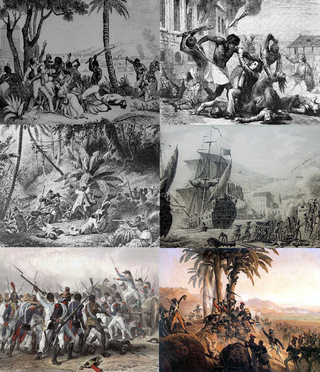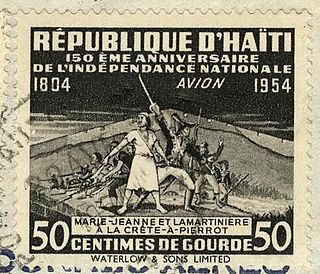
Henri Christophe was a key leader in the Haitian Revolution and the only monarch of the Kingdom of Haiti.

François-Dominique Toussaint Louverture also known as Toussaint L'Ouverture or Toussaint Bréda; 20 May 1743 – 7 April 1803) was a Haitian general and the most prominent leader of the Haitian Revolution. During his life, Louverture first fought and allied with Spanish forces against Saint-Domingue Royalists, then joined with Republican France, becoming Governor-General-for-life of Saint-Domingue, and lastly fought against Napoleon Bonaparte's Empire. As a revolutionary leader, Louverture displayed military and political acumen that helped transform the fledgling slave rebellion into a revolutionary movement. Louverture is now known as the "Father of Haiti".

Jean-Jacques Dessalines was the first Haitian Emperor, and leader of the Haitian Revolution, and the first ruler of an independent Haiti under the 1805 constitution. Initially regarded as governor-general, Dessalines was later named Emperor of Haiti as Jacques I (1804–1806) by generals of the Haitian Revolutionary army and ruled in that capacity until being assassinated in 1806. He spearheaded the resistance against French massacres upon Haitians, and eventually became the architect of the 1804 Haitian Massacre against the remaining French residents of Haiti, including some supporters of the revolution. He has been referred to as the father of the nation of Haiti.

Charles Victoire Emmanuel Leclerc was a French Army general who served under Napoleon Bonaparte during the French Revolution. He was husband to Pauline Bonaparte, sister to Napoleon. In 1801, he was sent to Saint-Domingue (Haiti), where an invasion force under his command captured and deported the Haitian leader Toussaint Louverture, as part of an unsuccessful attempt to reassert imperial control over Saint-Domingue and reinstate slavery on the local population. Leclerc died of yellow fever during the failed invasion.

Alexandre Sabès Pétion was the first president of the Republic of Haiti from 1807 until his death in 1818. One of Haiti's founding fathers, Pétion belonged to the revolutionary quartet that also includes Toussaint Louverture, Jean-Jacques Dessalines, and his later rival Henri Christophe. Regarded as an excellent artilleryman in his early adulthood, Pétion would distinguish himself as an esteemed military commander with experience leading both French and Haitian troops. The 1802 coalition formed by him and Dessalines against French forces led by Charles Leclerc would prove to be a watershed moment in the decade-long conflict, eventually culminating in the decisive Haitian victory at the Battle of Vertières in 1803.

The flag of Haiti is the national flag of the Republic of Haiti. It is a bicolour flag featuring two horizontal bands coloured blue and red, emblazoned by a white rectangular panel bearing the coat of arms of Haiti. The coat of arms depicts a trophy of weapons atop a green hill and a royal palm symbolizing independence. The palm is topped by the Cap of Liberty. The motto L'Union fait la Force appears on a white ribbon below the arrangement.

Ouest (French) or Lwès is one of the ten departments of Haiti. It is located in south-central Haiti, linking the Great-North and the Tiburon Peninsula.

The Haitian Revolution was a successful insurrection by self-liberated slaves against French colonial rule in Saint-Domingue, now the sovereign state of Haiti. The revolt began on 22 August 1791, and ended in 1804 with the former colony's independence. It involved black, biracial, French, Spanish, British, and Polish participants—with the ex-slave Toussaint Louverture emerging as Haiti's most prominent general. The revolution was the only slave uprising that led to the founding of a state which was both free from slavery and ruled by non-whites and former captives. The successful revolution was a defining moment in the history of the Atlantic World and the revolution's effects on the institution of slavery were felt throughout the Americas. The end of French rule and the abolition of slavery in the former colony was followed by a successful defense of the freedoms the former slaves had won, and with the collaboration of already free people of color, of their independence from white Europeans.

The Battle of Vertières was the last major battle of the Haitian Revolution, and the final part of the Revolution under Jean Jacques Dessalines. It was fought on 18 November 1803 between the enslaved Haitian army and Napoleon's French expeditionary forces, who were committed to regaining control of the island.

Donatien-Marie-Joseph de Vimeur, vicomte de Rochambeau was a French military commander and white supremacist. He was the son of Jean-Baptiste Donatien de Vimeur, comte de Rochambeau.

The State of Haiti was the name of the state in northern Haiti. It was created on 17 October 1806 following the assassination of Emperor Jacques I and the overthrow of the First Empire of Haiti. The northern State of Haiti was ruled by Henri Christophe originally as Provisional Chief of the Haitian Government from 17 October 1806 until 17 February 1807 when he became President of the State of Haiti. The 1807 constitution for the State of Haiti made the post of president a position for life with the president having the power to appoint his successor. On 28 March 1811 President Henri was proclaimed King Henri I, thereby dissolving the State of Haiti and creating the Kingdom of Haiti.

The Haitian Declaration of Independence was proclaimed on 1 January 1804 in the port city of Gonaïves by Jean-Jacques Dessalines, marking the end of 13-year long Haitian Revolution. The declaration marked Haiti becoming the first independent nation of Latin America and only the second in the Americas after the United States.
Joseph R. E. Bunel was a representative of the Haitian Revolutionary Government, who negotiated the first trade agreement between his nation and the United States, in 1799.
Marie Sainte Dédée Bazile, known as Défilée and Défilée-La-Folle, is a figure of the Haitian Revolution. She is remembered for retrieving and burying the mutilated body of Emperor Dessalines after his assassination at Pont Larnage.

Marie-Jeanne Lamartinière, known in history only as "Marie-Jeanne", was a Haitian soldier, and reportedly a "dazzling beauty." She served in the Haitian army during the Haitian Revolution (1791–1804).

The 1804 Haiti massacre, sometimes referred to as the Haitian Genocide, was carried out by Afro-Haitian soldiers, mostly former slaves, under orders from Jean-Jacques Dessalines against much of the remaining European population in Haiti, which mainly included French people. The Haitian Revolution defeated the French army in November 1803 and the Haitian Declaration of Independence happened on 1 January 1804. From February 1804 until 22 April 1804, squads of soldiers moved from house to house throughout Haiti, torturing and killing entire families. Between 3,000 and 5,000 people were killed.

The Indigenous Army, also known as the Army of Saint-Domingue or Lame Endijèn in Haitian Creole, was the name bestowed to the coalition of anti-slavery men and women who fought in the Haitian Revolution in Saint-Domingue. Encompassing both black slaves, maroons, and affranchis, the rebels were not officially titled the Armée indigène until January 1803, under the leadership of then-general Jean-Jacques Dessalines. Predated by insurrectionists such as François Mackandal, Vincent Ogé and Dutty Boukman, Toussaint Louverture, succeeded by Dessalines, led, organized, and consolidated the rebellion. The now full-fledged fighting force utilized its manpower advantage and strategic capacity to overwhelm French troops, ensuring the Haitian Revolution was the most successful of its kind.
During the Haitian Revolution (1791–1804), Haitian women of all social positions participated in the revolt that successfully ousted French colonial power from the island. In spite of their various important roles in the Haitian Revolution, women revolutionaries have rarely been included within historical and literary narratives of the slave revolts. However, in recent years extensive academic research has been dedicated to their part in the revolution.
Charles Belair (1760–1802) was Aide-de-Camp and lieutenant of Toussaint Louverture, Head of the 7th demi-brigade, Commandant of l'Arcahaye and Former lieutenant of Biassou. He was also a nephew of Toussaint Louverture. In 1796, he married Sanite Belair.
In 1789 is made the Declaration of the Rights of Man and of the Citizen, set by France's National Constituent Assembly. In 1791, the enslaved Africans of Saint-Domingue began the Haitian Revolution, aimed at the overthrow of the colonial regime.















